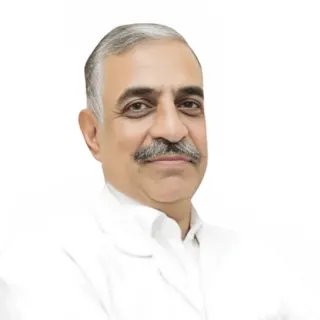Best Liver Transplant Surgeons in Artemis Hospital Gurgaon
 24 December,2025
Read More
24 December,2025
Read More
Starting From: USD 200-2000
Hospitalization Days: - Days
Procedure Duration: - Hrs
Peripheral Hemangioma Sclerotherapy is affordable in India. The cost of Peripheral Hemangioma Sclerotherapy in India lies between USD 200-2000. The exact procedure price depends on multiple factors such as the surgeon's experience, type of hospital, severity of the condition, patient's general condition,�etc.
Peripheral hemangioma sclerotherapy is a minimally invasive procedure used to treat vascular malformations or tumors known as hemangiomas. During the procedure, a sclerosing agent is injected directly into the hemangioma, causing it to shrink and eventually disappear. This technique effectively reduces the size and symptoms of the hemangioma, such as pain or cosmetic concerns. Sclerotherapy is often performed in an outpatient setting and typically requires multiple treatment sessions for optimal results. It offers a safe and effective alternative to surgical removal for managing peripheral hemangiomas.
Peripheral hemangioma sclerotherapy may be necessary to address vascular malformations or tumors known as hemangiomas. Here are some reasons why peripheral hemangioma sclerotherapy may be needed:
Peripheral hemangioma sclerotherapy is performed to improve symptoms, enhance cosmetic appearance, prevent complications, and restore function in individuals with hemangiomas. The procedure offers a minimally invasive approach to managing these vascular abnormalities, often with favorable outcomes and minimal downtime.
Peripheral hemangioma sclerotherapy encompasses several techniques aimed at treating vascular malformations or tumors known as hemangiomas. Here are some common types of peripheral hemangioma sclerotherapy:
The choice of peripheral hemangioma sclerotherapy technique depends on factors such as the size, location, and type of hemangioma, as well as the patient's characteristics and treatment goals. The most appropriate technique is determined on a case-by-case basis by the healthcare provider.
Patients are selected for peripheral hemangioma sclerotherapy based on various factors, including the characteristics of the hemangioma, the patient's overall health, and treatment goals. Here's how patients are typically evaluated and selected for the procedure:
Patient selection for peripheral hemangioma sclerotherapy involves a comprehensive evaluation of clinical symptoms, imaging findings, medical history, treatment goals, and risk factors to ensure that the procedure is safe and likely to achieve optimal outcomes for the patient.
Peripheral hemangioma sclerotherapy offers both benefits and risks, which must be carefully considered before undergoing the procedure.
The benefits of peripheral hemangioma sclerotherapy in reducing symptoms and improving cosmetic appearance often outweigh the risks for many patients. However, it's essential to discuss these risks and benefits with a healthcare provider to make an informed treatment decision.
After undergoing peripheral hemangioma sclerotherapy, patients can expect a period of recovery and follow-up care. Here's what to expect after the procedure:
The recovery process after peripheral hemangioma sclerotherapy involves monitoring for complications, practicing good skin care, attending follow-up appointments, and being patient as the treated area heals and symptoms improve.
Peripheral hemangioma sclerotherapy is a minimally invasive procedure performed in a clinic or outpatient setting. Here's an overview of how it is typically performed:
Peripheral hemangioma sclerotherapy is a relatively quick and straightforward procedure that effectively treats vascular malformations with minimal discomfort and downtime for patients.

Director
Cardiothoracic and Vascular Surgeon
Medica Superspecialty Hospital, Kolkata

Director
Cardiothoracic and Vascular Surgeon
Fortis Escorts Heart Institute, New Delhi

Senior Consultant
Cardiothoracic and Vascular Surgeon
Apollo Hospital Chennai, Greams Road

Chairman
Cardiothoracic and Vascular Surgeon
Medanta - The Medicity Hospital, Gurgaon


Head of Department (HOD)
Cardiothoracic and Vascular Surgeon
Manipal Hospital Formerly Columbia Asia, Palam Vihar, Gurgaon
Doctor of Pharmacy
Dr. Deepanshu Siwach is a skilled clinical pharmacist with a Doctor of Pharmacy degree.?He has 4+?years of experience and has worked with thousands of patients. He has been associated with some of the top hospitals, such as Artemis Gurgaon.
Dr. Deepanshu Siwach is a skilled clinical pharmacist with a Doctor of Pharmacy degree.?He has 4+?years of experience and has worked with thousands of patients. He has been associated with some of the top hospitals, such as Artemis Gurgaon....
Peripheral hemangioma sclerotherapy typically takes around 30 minutes to an hour to complete, depending on the size and extent of the hemangioma being treated. However, this can vary based on individual factors and the number of injections required. Patients should consult with their healthcare provider for specific details regarding the duration of their sclerotherapy procedure.
The success rate of peripheral hemangioma sclerotherapy varies depending on factors such as the size, location, and type of hemangioma, as well as the individual patient's response to treatment. Generally, sclerotherapy is effective in reducing the size and symptoms of hemangiomas in a significant proportion of patients, leading to improved quality of life and cosmetic outcomes.
Patients can typically return to normal activities within a day or two after peripheral hemangioma sclerotherapy. However, this may vary depending on individual factors such as the size and location of the treated hemangioma and any associated discomfort or swelling. Patients should follow their healthcare provider's instructions and avoid strenuous activities until they are fully healed.
The duration of the effects of peripheral hemangioma sclerotherapy varies depending on factors such as the size and type of the hemangioma, the effectiveness of the sclerotherapy treatment, and individual patient characteristics. In many cases, sclerotherapy can lead to a long-lasting reduction in the size and symptoms of the hemangioma, providing sustained relief and cosmetic improvement for the patient.
Yes, alternative treatments to peripheral hemangioma sclerotherapy exist. These may include surgical interventions such as excision or laser therapy, cryotherapy, embolization, or observation without intervention, depending on factors such as the size, location, and type of the hemangioma, as well as the patient's overall health and treatment goals. It's important to discuss these options with a healthcare provider to determine the most appropriate treatment approach.
The Art of Effective Communication
 24 December,2025
Read More
24 December,2025
Read More
 23 December,2025
Read More
23 December,2025
Read More
 17 December,2025
Read More
17 December,2025
Read More
 16 December,2025
Read More
16 December,2025
Read More
 10 December,2025
Read More
10 December,2025
Read More
 09 December,2025
Read More
09 December,2025
Read More